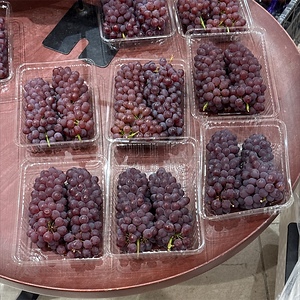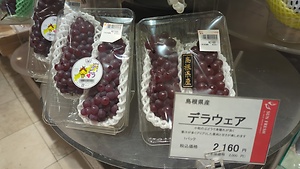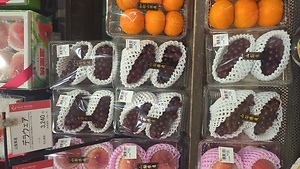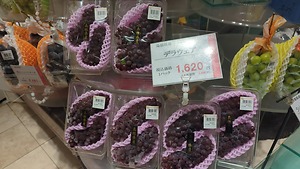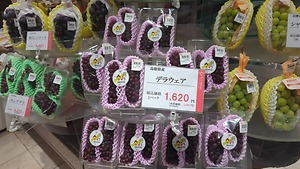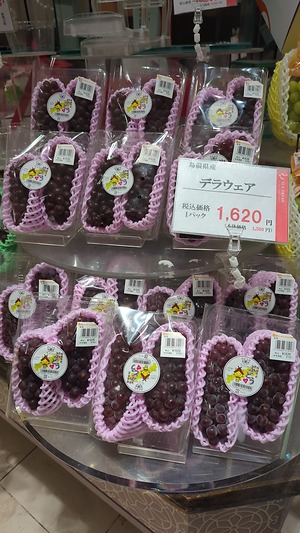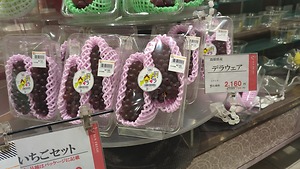

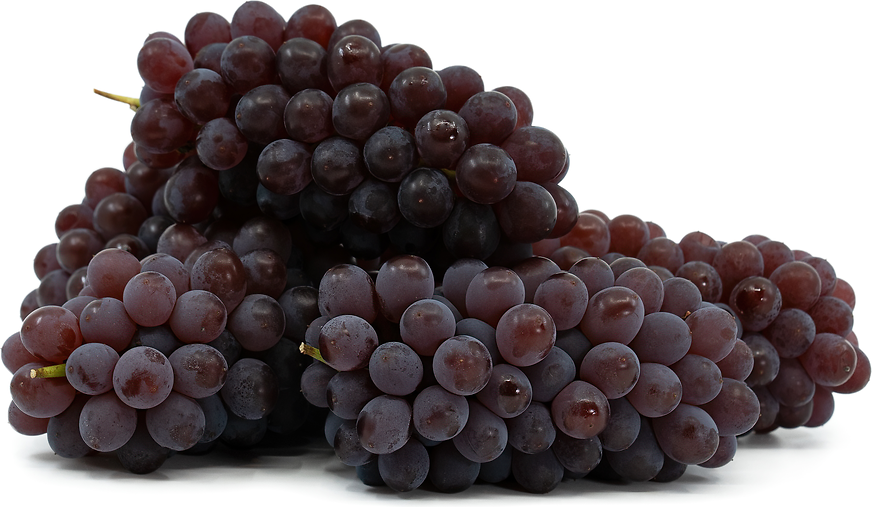
Delaware Grapes
Estimated Inventory, lb : 0
Description/Taste
Delaware grapes are a small to medium-sized varietal, growing in tightly packed, clustered oval bunches. Each grape within the bunch averages around one centimeter in diameter, and the grapes have a round to oval appearance. The skin is thin, tender, delicate, and known as a slip-skin variety, which describes how the skin is easily separated from the flesh with gentle pressure. The skin is also smooth and taut, ripening from green to pale red-purple when ripe, sometimes appearing almost pink, and is covered in a white powdery bloom. Underneath the surface, the flesh is soft, aqueous, and succulent, containing a few to no seeds, depending on cultivation practices. Delaware grapes have a subtle aroma and high sugar content, ranging from 18 to 20 Brix. These high sugar levels contribute to the grape’s sweet, fruity flavor, and there is also subtle acidity, creating a light tart and tangy aftertaste.
Seasons/Availability
Delaware grapes are available in the summer through fall.
Current Facts
Delaware grapes, botanically a part of the Vitis genus, are a sweet hybrid variety belonging to the Vitaceae family. The grapes were discovered in the eastern United States in the early 19th century and are an early-ripening variety highly favored for their mild, sweet, and subtly acidic flavor. Delaware grapes were named after the city of Delaware in Ohio, one of the first places the grapes were grown before they became commercially popular. Delaware grapes are a smaller variety, and one bunch can easily fit into the palm of a hand. The sweet, easily peeled grapes are primarily used for wine production in the United States. In Japan and South Korea, Delaware grapes are one of the most popular table grape varieties and are consumed chilled as a sweet snack.
Nutritional Value
Delaware grapes contain vitamin A to maintain healthy organ functioning and vitamin C to strengthen the immune system while reducing inflammation. The grapes also contain potassium to balance fluid levels within the body, calcium to protect bones and teeth, B vitamins to break down fats for energy, and iron to develop the protein hemoglobin for oxygen transport through the bloodstream.
Applications
Delaware grapes have a sweet, subtly acidic flavor well suited for raw preparations. In the United States, the grapes are primarily processed into dry, sweet, or sparkling wines and impart a delicate sweetness on the palate, with hints of green apple and a slight spicy nuance. Delaware grapes give a light pink hue to wines, and despite their red coloring, they are mainly used to make a rose, white, or sparkling wine. The grapes are also sometimes pressed into juices. In Japan and South Korea, Delaware grapes are sold as table grapes and are preferably chilled and consumed straight, out of hand. The skins can be easily removed or slipped from the flesh, and the grape’s flesh can be tossed into salads, blended into smoothies, or sliced and used as a fresh topping over desserts, ice cream, and breakfast dishes. The grapes can also be incorporated into tarts, cakes, and panna cotta, or they can be simmered into jellies. Delaware grapes pair well with fruits such as melon, strawberries, raspberries, and blueberries, meats including beef, poultry, and pork, cheeses such as brie, cheddar, ricotta, goat, and feta, vanilla, and herbs such as mint, rosemary, parsley, and basil. Whole, unwashed Delaware grapes will keep 2 to 4 days when stored in a plastic bag and kept in the refrigerator.
Ethnic/Cultural Info
Delaware grapes are one of Japan's most commercially produced grape varieties, cultivated as a sweet-flavored table grape. The variety was initially introduced to Japan as a more affordable table grape during a time when grapes were not readily accessible to all social classes. Delaware grapes became a popular alternative to the more expensive kyoho and muscat alexandria grapes in the late 19th century, and Japanese consumers appreciated the variety’s slip-skin nature, easily removing the skins before consumption. In modern-day Japan, growers have developed a hormone known as gibberellin that causes the fruits to be seedless, and these grapes have become a popular seasonal gift to friends, family members, and colleagues.
Geography/History
Delaware grapes are native to the eastern United States, and the earliest records of the variety were traced back to the farm of Paul Henri Mallet-Prevost in Frenchtown, New Jersey. Prevost was a Swiss aristocrat who owned land in New Jersey, but much is unknown whether the variety was given to Prevost or was created in his garden. The parent varieties of the hybrid grape are also unknown, but experts believe the grape is derived from Vitis labrusca and Vitis aestivalis crossed with some Vitis vinifera. From Prevost’s home garden in New Jersey, Delaware grapes were given to a Mr. Warford in Ohio, who later gave the variety to Benjamin Heath in 1837. Heath’s neighbor, newspaper editor Abraham Thompson, acquired cuttings from Heath and began researching the grape while growing it in 1849. Thompson contacted the Ohio Pomological Society in 1851, who traced the variety back to Prevost’s farm, but Prevost had passed away before the grape’s origins could be revealed. Thompson initially called the variety Heath or Powell grapes, but when he sent them to AJ Downing, editor of The Horticulturist magazine, Downing named them Delaware grapes since the samples he received were sent from Delaware, Ohio. The name Delaware stuck, and the variety was officially named in the 1850s when it was added to the American Pomological Society’s grape list. In 1872, Delaware grapes were imported to Japan, and commercial cultivation began in 1886 in the Yamanashi Prefecture. Today Delaware grapes are grown throughout Japan, with the highest production occurring in the Yamagata Prefecture. The variety is also cultivated in the Yamanashi, Shimane, Osaka Prefectures, and South Korea. Outside of Asia, Delaware grapes are grown in the United States and in regions of Europe.
Recipe Ideas
Recipes that include Delaware Grapes. One
| Cassie Craves |
|
Sweet Grape Salad |
| NM Meiyee |
|
Blackberry & White Chocolate Tart ( Vegan & Gluten-Free) |



